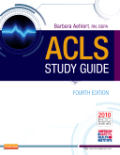
Reflecting the 2010 Emergency Cardiovascular Care guidelines, ACLS Study Guide, 4th Edition offers a complete, full-color overview of advanced cardiovascular life support. An easy-to-read approach covers everything from airway management and rhythms and their management to electrical therapy, acute coronary syndromes, and acute stroke. In addition to the latest ACLS treatment algorithms, this edition includes new case studies, new photos and illustrations, a heart rate ruler, and a handy ACLS quick-reference card for use in the field. Written by Barbara Aehlert, ACLS Study Guide is the official textbook for the American Safety & Health Institute ACLS certification course. INDICE: Pretest Pretest Answers PART I: PREPARATORY 1. The ABCDs of Emergency Cardiovascular Care Introduction Risk Factors for Coronary Artery Disease Sudden Cardiac Death Chain of Survival - Early Recognition and Activation - Early CPR - Early Defibrillation - Early Advanced Cardiac Life Support - Integration of Post-Cardiac Arrest Care Phases of Cardiopulmonary Resuscitation Patient Assessment - Scene Safety - General Impression - Primary Survey - SecondarySurvey Stop and Review Stop and Review Answers 2. Airway Management: Oxygenation and Ventilation Anatomy of the Respiratory System - Upper Airway - Lower Airway Lung Volumes and Capacities - Lung Volumes - Lung Capacities - Ventilation Rates Devices for Assessing Oxygenation and Ventilation - Pulse Oximetry - Carbon Dioxide Monitoring Oxygen Delivery Devices - Nasal Cannula - Simple Face Mask - Partial Rebreather Mask - Nonrebreather Mask Manual Airway Maneuvers - Head Tilt-chin Lift - Jaw Thrust - Jaw Thrust without Head Tilt Suctioning -Purpose of Suctioning - Suction Catheters - Upper Airway Suctioning - Lower Airway Suctioning Airway Adjuncts - Oral Airway - Nasal Airway Techniques of Positive Pressure Ventilation - Mouth-to-Barrier Device Ventilation - Mouth-to-Mask Ventilation - Bag-Mask Ventilation Advanced Airways - Esophageal-Tracheal Combitube - King Laryngeal Tube Airway - Laryngeal Mask Airway - Tracheal Intubation Stop and Review Stop and Review Answers 3. Rhythms and Management Introduction Section 1: Anatomy Review and Basic Electrophysiology Coronary Arteries Basic Electrophysiology - Myocardial Cell Types - Properties of Cardiac Cells - Cardiac Action Potential - Refractory Periods - Conduction System The Electrocardiogram - Electrodes - Leads - Electrocardiogram Paper - Waveforms and Complexes - Segments and Intervals Rhythm Recognition - Sinus Rhythm - Sinus Arrhythmia Section 2: Tachydysrhythmias: Too Fast Rhythms Narrow-QRS Tachycardias - Sinus Tachycardia - Atrial Tachycardia - AV Nodal Reentrant Tachycardia - AV Reentrant Tachycardia - Junctional Tachycardia Wide-QRS Tachycardias - Intraventricular Conduction Defects - Accelerated Idioventricular Rhythm - Ventricular Tachycardia Irregular Tachycardias - Multifocal Atrial Tachycardia - Atrial Flutter and Atrial Fibrillation - Polymorphic Ventricular Tachycardia Section 3: Bradydysrhythmias: Too Slow Rhythms Sinus Bradycardia - What Causes It? - What Do I Do About It? Junctional Escape Rhythm - What Causes It? - What Do I Do About It? Ventricular Escape Rhythm - What Causes It? - What Do I Do About It? Atrioventricular (AV) Blocks - First-Degree AV Block - Second-Degree AV Blocks - Third-Degree AV Block Section 4: Cardiac Arrest Rhythms Ventricular Tachycardia Ventricular Fibrillation Asystole (Cardiac Standstill) Pulseless Electrical Activity The Resuscitation Team - Goals of the Resuscitation Team - Configuration of the Resuscitation Team - Code Organization - "Phase Response" - Helping the Caregivers Stop and Review Stop and Review Answers 4. ElectricalTherapy Introduction Defibrillation - Definition and Purpose - Energy, Voltage, and Current - Monophasic versus Biphasic Defibrillation - Transthoracic Impedance - Defibrillation à Procedure Automated External Defibrillators (AEDs) - AED Features - AED Operation - Special Considerations - Maintenance Synchronized Cardioversion - Description and Purpose - Procedure Defibrillation and Cardioversion - Special Considerations - Possible Complications - Possible Errors Transcutaneous Pacing - Procedure - Limitations - Possible Complications - Pacemaker Malfunction Stop and Review Stop and Review Answers 5. Acute CoronarySyndromes Introduction Pathophysiology of Acute Coronary Syndromes - Plaque Rupture - Thrombus Development - Coronary Artery Obstruction - Other Causes of Acute Coronary Syndromes Forms of Acute Coronary Syndromes - Unstable Angina -Myocardial Infarction History and Clinical Presentation - Patient History - Typical Symptoms - Anginal Equivalents - Atypical Presentation - Physical Examination Patient Evaluation - Electrocardiogram Findings - Cardiac Biomarkers - Imaging Studies Initial Management of Acute Coronary Syndromes - General Measures - Analgesic and Anti-ischemic Therapy - Antiplatelet Therapy - Aspirin andClopidogrel - Glycoprotein IIb/IIIa Inhibitors - Anticoagulant Therapy - Percutaneous Coronary Intervention - Fibrinolytic Therapy - Coronary Artery BypassGraft Surgery Complications of Acute Myocardial Infarction - Dysrhythmias - Ventricular aneurysm - Ventricular septal rupture - Papillary muscle rupture - Cardiac wall rupture - Hypotension - Ventricular Failure - Pericarditis - Embolic Complications Stop and Review Stop and Review Answers 6. Acute Stroke Objectives Introduction Stroke Facts Classification of Stroke by Anatomic LocationIschemic and Hemorrhagic Stroke - Ischemic Stroke - Hemorrhagic Stroke StrokeChain of Survival - Detection - Dispatch - Delivery - Door - Data - Decision - Drug - Disposition Stop and Review Stop and Review Answers PART II: CASE STUDIES Case 1: Respiratory Arrest Case 2: Pulseless Ventricular Tachycardia/Ventricular Fibrillation with an AED Case 3: Pulseless Ventricular Tachycardia/Ventricular Fibrillation Case 4: Asystole Case 5: Pulseless Electrical Activity Case 6: Acute Coronary Syndromes Case 7: Symptomatic Bradycardia Case 8: Unstable Tachycardia NEW! Case 9: Stable Tachycardia NEW! Case 10: Acute Ischemic Stroke NEW! Posttest - Posttest Answers Answer Appendix Glossary
- ISBN: 978-0-323-08449-9
- Editorial: Mosby-Elsevier
- Encuadernacion: Rústica
- Páginas: 424
- Fecha Publicación: 31/01/2012
- Nº Volúmenes: 1
- Idioma: Inglés
